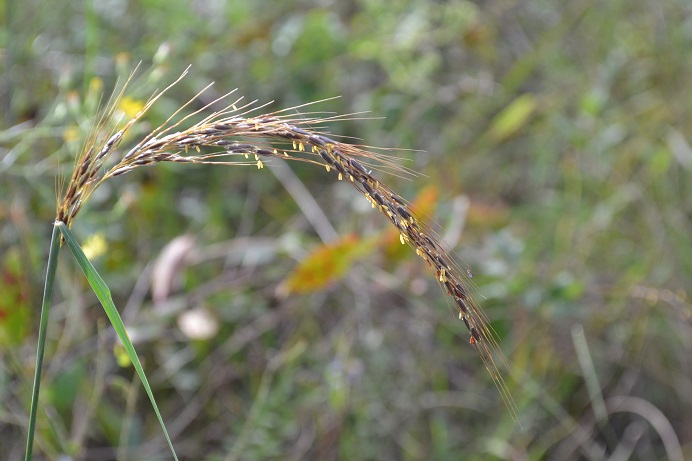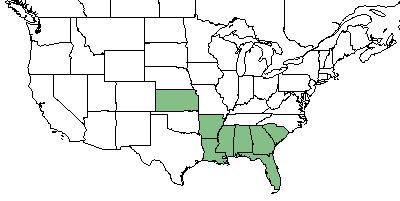Difference between revisions of "Sorghastrum secundum"
| Line 42: | Line 42: | ||
===Use by animals=== <!--Herbivory, granivory, insect hosting, etc.--> | ===Use by animals=== <!--Herbivory, granivory, insect hosting, etc.--> | ||
| − | ''S. secundum'' consists of 2-5% of the diet for terrestrial birds.<ref name="Miller & Miller 1999">Miller JH, Miller KV (1999) Forest plants of the southeast and their wildlife uses. Southern Weed Science Society.</ref> Fire ants (''Solenopsis invicta''), do not show an interest in ''S. secundum'' seeds.<ref name="Cumberland & Kirkman 2013">Cumberland MS, Kirkman LK (2013) The effects of the red imported fire ant on seed fate in the longleaf pine ecosystem. Plant Ecology 214:717-724.</ref> | + | ''S. secundum'' consists of 2-5% of the diet for terrestrial birds.<ref name="Miller & Miller 1999">Miller JH, Miller KV (1999) Forest plants of the southeast and their wildlife uses. Southern Weed Science Society.</ref> Fire ants (''Solenopsis invicta''), do not show an interest in ''S. secundum'' seeds.<ref name="Cumberland & Kirkman 2013">Cumberland MS, Kirkman LK (2013) The effects of the red imported fire ant on seed fate in the longleaf pine ecosystem. Plant Ecology 214:717-724.</ref> In the southeastern United States, it is also grazed year round.<ref name="Penfield 2006">Penfield S (2006) Notes on some characteristics of lopsided indiangrass (''Sorghastrum secundum'')</ref> |
==Diseases and parasites== | ==Diseases and parasites== | ||
Revision as of 18:33, 16 January 2018
| Sorghastrum secundum | |
|---|---|

| |
| Photo by Kevin Robertson | |
| Scientific classification | |
| Kingdom: | Plantae |
| Division: | Magnoliophyta - Flowering plants |
| Class: | Liliopsida - Moncots |
| Order: | Poales |
| Family: | Poaceae |
| Genus: | Sorghastrum |
| Species: | S. secundum |
| Binomial name | |
| Sorghastrum secundum (Elliott) Nash | |

| |
| Natural range of Sorghastrum secundum from USDA NRCS Plants Database. | |
Common Name(s): lopsided indiangrass[1][2]
Contents
Taxonomic Notes
Synonym(s): Andropogon secundus[2]
Description
Sorghastrum secundum is a monoecious perennial graminoid[2] that grows to 3-6 feet (0.91-1.83 m).[3] It is a tufted grass with short rhizomes.[4] Culms are erect to ascending and blades are up to 8.1 mm (0.32 in) wide and 42 cm (1.38 ft) long. Straight inflorescence with spikelets positioned all on one side helps distinguish this species.[5]
Distribution
S. secundum occurs from southern South Carolina, south to southern Florida, and westward to southern Alabama.[1]
Ecology
Habitat
This species is found on sandhills[1] and thinly wooded areas.[5] In peninsula Florida xeric sandhills, S. secundum was found in 100% of the plots with a mean cover of 0.0299 m2. Panhandle xeric sandhills contained S. secundum in 87% of plots and had a mean coverage of 0.0191 m2. Frequency and mean cover in North Florida longleaf woodlands was 100% and 0.04 m2 and 94% and 0.0273 m2 in North Florida subxeric sandhills, respectively.[6]
Phenology
Flowering occurs in September and October in Central Florida and northward.[1][5] In southern Florida, blooming begins in July.[5]. Seed germination seems to peak in January and February.[7]
Seed bank and germination
In south Georgia, S. secundum buried in seed bags had a 26% germination rate after one year, 34% after two, and 9% after four.[7]
Use by animals
S. secundum consists of 2-5% of the diet for terrestrial birds.[8] Fire ants (Solenopsis invicta), do not show an interest in S. secundum seeds.[9] In the southeastern United States, it is also grazed year round.[10]
Diseases and parasites
Its seeds are more prone to mold destroying it prior to germination compared to other seeds.[7]
Conservation and Management
Cultivation and restoration
Photo Gallery
References and notes
- ↑ 1.0 1.1 1.2 1.3 Weakley AS (2015) Flora of the Southern and Mid-Atlantic States. Chapel Hill, NC: University of North Carolina Herbarium.
- ↑ 2.0 2.1 2.2 USDA NRCS (2016) The PLANTS Database (http://plants.usda.gov, 16 January 2018). National Plant Data Team, Greensboro, NC 27401-4901 USA.
- ↑ Plant database: Sorghastrum secundum. (16 January 2018) Lady Bird Johnson Wildflower Center. URL: https://www.wildflower.org/plants/result.php?id_plant=SOSE5
- ↑ Dagley CM, Harrington TB, Edwards MB (2002) Understory restoration in longleaf pine plantations: Overstory effects of competition and needlefall. In: Outcalt KW ed. Proceedings of the eleventh biennial southern silvicultural research conference. General Technical Report SRS-48. Asheville, NC: U.S. Department of Agriculture, Forest Service, Southern Research Station.
- ↑ 5.0 5.1 5.2 5.3 Hall DW (1982) Sorghastrum (Poaceae) in Florida. SIDA 9(4):302-308.
- ↑ Carr SC, Robertson KM, Peet RK (2010) A vegetation classification of fire-dependent pinelands of Florida. Castanea 75(2):153-189.
- ↑ 7.0 7.1 7.2 Coffey KL, Kirkman LK (2006) Seed germination strategies of species with restoration potential in a fire maintained pine savanna. Natural Areas Journal 26(3):289-299.
- ↑ Miller JH, Miller KV (1999) Forest plants of the southeast and their wildlife uses. Southern Weed Science Society.
- ↑ Cumberland MS, Kirkman LK (2013) The effects of the red imported fire ant on seed fate in the longleaf pine ecosystem. Plant Ecology 214:717-724.
- ↑ Penfield S (2006) Notes on some characteristics of lopsided indiangrass (Sorghastrum secundum)